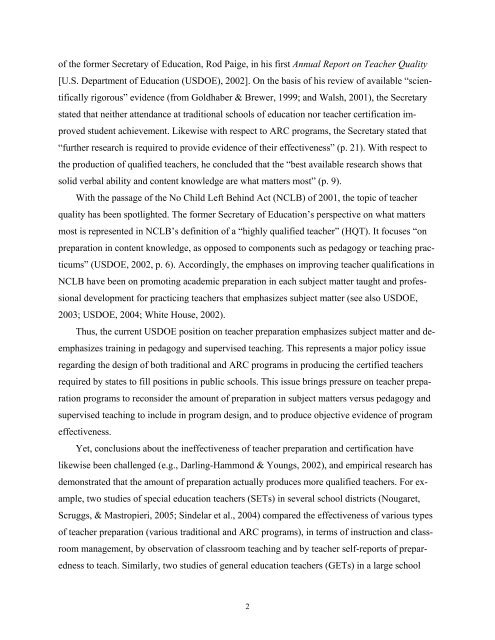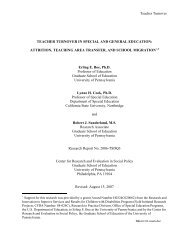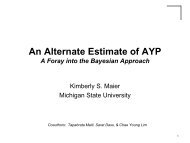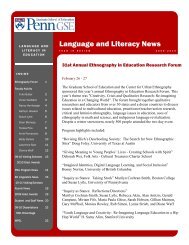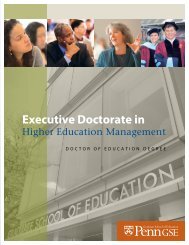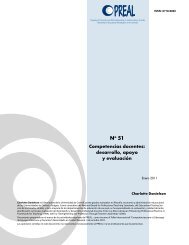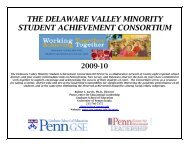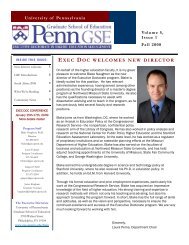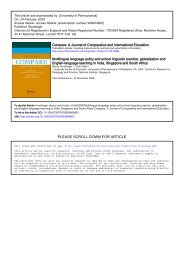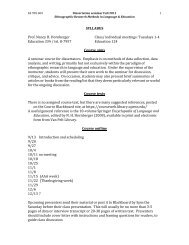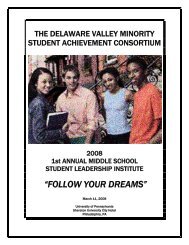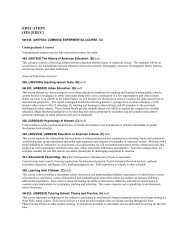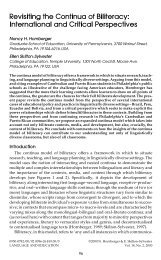does teacher preparation matter for beginning teachers in
does teacher preparation matter for beginning teachers in
does teacher preparation matter for beginning teachers in
Create successful ePaper yourself
Turn your PDF publications into a flip-book with our unique Google optimized e-Paper software.
of the <strong>for</strong>mer Secretary of Education, Rod Paige, <strong>in</strong> his first Annual Report on Teacher Quality<br />
[U.S. Department of Education (USDOE), 2002]. On the basis of his review of available “scientifically<br />
rigorous” evidence (from Goldhaber & Brewer, 1999; and Walsh, 2001), the Secretary<br />
stated that neither attendance at traditional schools of education nor <strong>teacher</strong> certification improved<br />
student achievement. Likewise with respect to ARC programs, the Secretary stated that<br />
“further research is required to provide evidence of their effectiveness” (p. 21). With respect to<br />
the production of qualified <strong>teacher</strong>s, he concluded that the “best available research shows that<br />
solid verbal ability and content knowledge are what <strong>matter</strong>s most” (p. 9).<br />
With the passage of the No Child Left Beh<strong>in</strong>d Act (NCLB) of 2001, the topic of <strong>teacher</strong><br />
quality has been spotlighted. The <strong>for</strong>mer Secretary of Education’s perspective on what <strong>matter</strong>s<br />
most is represented <strong>in</strong> NCLB’s def<strong>in</strong>ition of a “highly qualified <strong>teacher</strong>” (HQT). It focuses “on<br />
<strong>preparation</strong> <strong>in</strong> content knowledge, as opposed to components such as pedagogy or teach<strong>in</strong>g practicums”<br />
(USDOE, 2002, p. 6). Accord<strong>in</strong>gly, the emphases on improv<strong>in</strong>g <strong>teacher</strong> qualifications <strong>in</strong><br />
NCLB have been on promot<strong>in</strong>g academic <strong>preparation</strong> <strong>in</strong> each subject <strong>matter</strong> taught and professional<br />
development <strong>for</strong> practic<strong>in</strong>g <strong>teacher</strong>s that emphasizes subject <strong>matter</strong> (see also USDOE,<br />
2003; USDOE, 2004; White House, 2002).<br />
Thus, the current USDOE position on <strong>teacher</strong> <strong>preparation</strong> emphasizes subject <strong>matter</strong> and deemphasizes<br />
tra<strong>in</strong><strong>in</strong>g <strong>in</strong> pedagogy and supervised teach<strong>in</strong>g. This represents a major policy issue<br />
regard<strong>in</strong>g the design of both traditional and ARC programs <strong>in</strong> produc<strong>in</strong>g the certified <strong>teacher</strong>s<br />
required by states to fill positions <strong>in</strong> public schools. This issue br<strong>in</strong>gs pressure on <strong>teacher</strong> <strong>preparation</strong><br />
programs to reconsider the amount of <strong>preparation</strong> <strong>in</strong> subject <strong>matter</strong>s versus pedagogy and<br />
supervised teach<strong>in</strong>g to <strong>in</strong>clude <strong>in</strong> program design, and to produce objective evidence of program<br />
effectiveness.<br />
Yet, conclusions about the <strong>in</strong>effectiveness of <strong>teacher</strong> <strong>preparation</strong> and certification have<br />
likewise been challenged (e.g., Darl<strong>in</strong>g-Hammond & Youngs, 2002), and empirical research has<br />
demonstrated that the amount of <strong>preparation</strong> actually produces more qualified <strong>teacher</strong>s. For example,<br />
two studies of special education <strong>teacher</strong>s (SETs) <strong>in</strong> several school districts (Nougaret,<br />
Scruggs, & Mastropieri, 2005; S<strong>in</strong>delar et al., 2004) compared the effectiveness of various types<br />
of <strong>teacher</strong> <strong>preparation</strong> (various traditional and ARC programs), <strong>in</strong> terms of <strong>in</strong>struction and classroom<br />
management, by observation of classroom teach<strong>in</strong>g and by <strong>teacher</strong> self-reports of preparedness<br />
to teach. Similarly, two studies of general education <strong>teacher</strong>s (GETs) <strong>in</strong> a large school<br />
2


